 The Buckeye House Rabbit
Society
The Buckeye House Rabbit
Society
 The Buckeye House Rabbit
Society
The Buckeye House Rabbit
Society
Dental Disease in Rabbits by Dr. Cathy Palomar
TheHairHare Salon by Herta Rodina
The Healing Art of Rabbits by Eileen Matias
Rabbit Veterinarian Directory
go to index
by Dr. Cathy Palomar, DVM
VCA Midpark Animal Hospital
Middleburg Heights, Ohio
Have you looked at your rabbit's teeth lately? Dental problems are common in rabbits because their teeth grow continuously. Rabbits have 28 teeth, not just the four incisors that can easily be seen in the front of the mouth. They have 2 small teeth just behind the 2 top incisors. These small teeth are called the "peg teeth". They also have 22 premolars and molars called the "cheek teeth". Any thorough examination by a veterinarian should include using an otoscope to see the cheek teeth. The molars are made to chew a high fiber diet (hay and dark leafy greens). Rabbits' mouths are small, their tongues are large, and their lower jaws are often too narrow or too short. This can lead to teeth misalignment. They chew horizontally and vertically so that the teeth wear down evenly.
Signs of disease include poor appetite, drooling or wetness around the mouth, dewlap and front legs; grinding the teeth excessively (some rabbits will grind their teeth normally or from other sources of pain); dropping food out of the mouth; and bad breath. If you suspect a problem with your rabbit's teeth, you should have him examined quickly because little problems can become serious quite rapidly.
There are usually three causes of dental problems in rabbits. The first cause is congenital (present at birth) sometimes due to a recessive gene. It is most common in the dwarf breeds and some lop-eared breeds. It can involve both incisors and the cheek teeth. The second common cause is infection, mostly due to the bacteria Pasteurella and Staphylococcus. Infection can involve the incisors and molars, and can lead to malocclusion (the teeth do not line up properly and as a result overgrow) and abscesses (localized accumulations of pus). The third common cause is injury to the head and teeth. Injuries often happen from chewing cage wires or falling.
Diagnosing disease in the rabbit's mouth may be as simple as a good examination, or may require involved tests, such as sedation or anesthesia, x-rays, and culture (sending a sample to the laboratory to find out which type of bacteria is causing the infection and which antibiotic is best to treat it).
If the incisors are overgrown, often you will notice them at home. Overgrown incisors should be trimmed with a dental drill or Dremel, not Roscoe nail trimmers! Nail trimmers can easily split the tooth and lead to even more problems. Overgrown incisors usually need to be trimmed every 4 to 6 weeks. Sometimes the best solution is to remove the teeth permanently. Rabbits pick up food with their lips and chew with their molars, so the incisors are not essential. We do not, however, recommend removing the incisors just because the rabbit is a chewer! These teeth must be removed under anesthesia. They have very long, curving roots and can break while being extracted, since they are very fragile. If they break, they must be removed later after having time to re-grow. The roots are flushed and the rabbit is sent home with antibiotics.
Molar disease can be much more difficult to diagnose and treat. Using an otoscope, the molars are examined for sharp points or sharp edges that cause sores, abrasions or "kissing lesions". These kissing lesions are generally found on the cheek if the sharp points are on the upper molars, or on the tongue if the points are on the lower molars. Sometimes sedation or anesthesia is required to perform a good exam. Molars can be trimmed if needed, however, the sharp points tend to recur eventually. If a molar is infected, the prognosis is more guarded. The tooth must be removed, and the area cleaned thoroughly. Some abscesses will invade into the jaw bone and can be frustrating to treat. Some rabbits will achieve complete healing, while others may need to be maintained on antibiotics for life.
To avoid dental problems, choose your pet carefully from a reliable organization; use caging material that cannot be easily chewed; and do not delay if signs of dental disease are present. Lastly don't forget to look at your rabbit's teeth on a regular basis.
Sources:
Rabbit Dentistry, Susan Brown, DVM
Rabbits: Physical Exam and Differential Diagnosis, Carolynn Harvey, DVM
Ferrets, Rabbits, and Rodents: Clinical Medicine and Surgery, Hillyer & Quesenberry
go to index
The
|
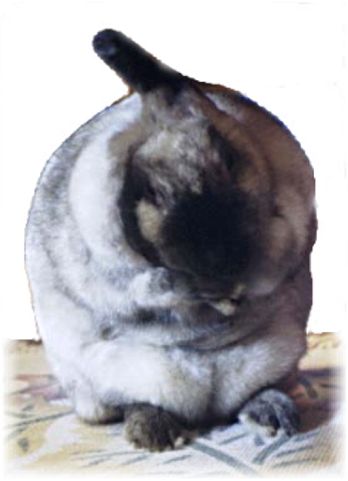 |
Anyone who has ever spent time in the company of rabbits knows that they're meticulous about their appearance. They keep themselves extremely clean, washing their face and ears, grooming their feet and toes, and licking their fur. In most cases, this behavior elicits a string of oooh's and aaah's from their human companions. It makes a cute photo.
 But, like most humans who need the professional skills of hair stylists and manicurists, rabbits require some extra help to look and feel their best. Brushing your rabbit on a regular basis is essential for maintaining his good health. This is true not only during shedding season, when ingesting large quantities of fur can lead to intestinal blockage, but throughout the year as well. Long-haired rabbits may require daily brushing to avoid mats and tangles; short-haired lagomorphs may need only weekly brushing when not shedding.
But, like most humans who need the professional skills of hair stylists and manicurists, rabbits require some extra help to look and feel their best. Brushing your rabbit on a regular basis is essential for maintaining his good health. This is true not only during shedding season, when ingesting large quantities of fur can lead to intestinal blockage, but throughout the year as well. Long-haired rabbits may require daily brushing to avoid mats and tangles; short-haired lagomorphs may need only weekly brushing when not shedding.
There are a number of different grooming tools on the market and you'll need to determine which work best for you and your rabbit. Slicker brushes - the flat, rectangular ones with short, soft wires - are a good choice for many rabbits. Select a size appropriate for your bunny and get into the habit of gently brushing him down his back, along his sides, on his stomach. Use the small comb that's sometimes included with the brush to clean the hair from the wires. A flea comb - similar in appearance to a human comb, but with long, widely-spaced teeth - can work well on some individuals. Most rabbits enjoy the attention and rhythmic motion of being brushed; some prefer light pressure while others like it stronger. If your rabbit really dislikes being brushed, consider using a grooming glove instead. Available in fabric or plastic, these gloves have short protrusions on one side that trap fur as you pet your bunny.
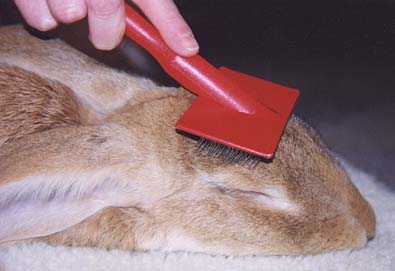 Regular brushing can help you spot small sores or wounds before they develop into big problems. A small patch of bare, reddened, or flaky skin may indicate the presence of parasites such as fleas or fur mites and should be treated by a veterinarian. In general, flea powders that are safe for kittens can be used on rabbits. Avoid flea baths or dips, because they can fatally stress a rabbit. All too often, we hear of a bunny who has died because of such well-intentioned, but overly-aggressive, treatment. To be certain, consult your vet before using any over-the-counter products.
Regular brushing can help you spot small sores or wounds before they develop into big problems. A small patch of bare, reddened, or flaky skin may indicate the presence of parasites such as fleas or fur mites and should be treated by a veterinarian. In general, flea powders that are safe for kittens can be used on rabbits. Avoid flea baths or dips, because they can fatally stress a rabbit. All too often, we hear of a bunny who has died because of such well-intentioned, but overly-aggressive, treatment. To be certain, consult your vet before using any over-the-counter products.
Good grooming doesn't stop with brushing. Toenails need attention too. Overgrown nails can get snagged on carpeting and lead to injury. A ripped or broken toenail, in addition to causing pain and bleeding, can become infected and lead to more serious problems. Regular clipping, usually every two to three months, keeps your rabbit's nails short and safe. Use guillotine-type nail clippers or nail scissors available in pet supply stores. Select the model you're most comfortable manipulating. Rabbits have four toes on each foot, plus a dew claw - in a similar position to our thumb - behind their front feet. This is easy to overlook, so don't forget to trim the dew claw! If your rabbit has light-colored nails, you're in luck because you can see the quick - the red vein extending up into the nail. Avoid cutting the quick, because it will bleed. If you accidentally do cut into the vein, use a styptic pencil (available in pet supply stores or from your vet) or cornstarch to stop the bleeding. If your rabbit has dark nails, you may find that shining a flashlight behind the nail allows you to see the quick. When in doubt, make small, conservative clips. If you've never clipped your rabbit's nails before or if you have a skittish rabbit or are nervous yourself, have your vet show you how. As with any task, your skill will improve with practice.
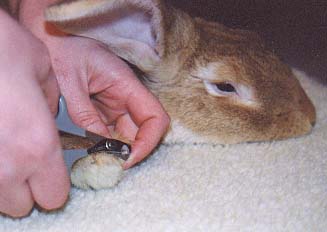 Nail trimming is often a two-person job, because many rabbits dislike having their feet touched, especially their back feet. One option is to wrap bunny in a towel so he feels secure. While one person holds him, the other can trim his nails, exposing one foot at a time. Another option is to accustom your rabbit to having his feet handled. When bunny is relaxed and enjoying a pet, gently hold one paw in your fingers and stroke it slowly. With time, this will become a routine and pleasurable experience and will make nail trimming less of a chore.
Nail trimming is often a two-person job, because many rabbits dislike having their feet touched, especially their back feet. One option is to wrap bunny in a towel so he feels secure. While one person holds him, the other can trim his nails, exposing one foot at a time. Another option is to accustom your rabbit to having his feet handled. When bunny is relaxed and enjoying a pet, gently hold one paw in your fingers and stroke it slowly. With time, this will become a routine and pleasurable experience and will make nail trimming less of a chore.
Finally, use these regular grooming sessions to monitor your rabbit's overall condition. Are his eyes bright and shiny? Or does he have wet fur from tearing? Is his nose dry? Or is there discharge? Are his ears clean? Or can you see waxy build-up or debris? Is the fur around his mouth clean and dry? Or is there evidence of drooling? Check for sores on his feet. Check his genital and anal area for wetness or irritation. If you discover any signs of illness or poor health, have your veterinarian check it out immediately.
Developing a consistent grooming routine yields more than just practical benefits. A brushing session, even for a few minutes, provides you with a serene pause in a busy day. It can help strengthen the bond between you and your bunny and become a pleasant experience for both of you. And, unlike your favorite salon, it's free!
go to index
by Eileen Matias
We all know how much joy our rabbits give us. Have you ever wondered what it would be like to share that joy? Back in June of 1998, the Humane Society of Greater Akron arranged for Annabelle Rabbit and me to start pet therapy at nursing homes. We visit two nursing homes in the area. Usually we are accompanied by Ben the dog and a kitten or cat. Ben and Annabelle are alumni of the Humane Society of Greater Akron. The cats are current residents waiting for adoption. The therapy we provide is very important and the animals know it.
Here are some true stories:
Catherine was withdrawn and showed little interest in life outside her room. When I put Annabelle in her arms she gave a big smile. Her reaction got the attention of the head nurse and the activities director.
Ron and Annabelle are such good friends now that Annabelle jumps in Ron's lap and will snuggle with him. When Ron sees his girl, he always says "Hey, good lookin'!" He laughs and holds her and just loves her.
Donna is blind and bed ridden. She calls Annabelle her buddy. Annabelle sits on Donna and looks right at her while Donna talks and tells jokes and strokes Annabelle's ears and back. Annabelle sometimes gets too comfortable on some of the residents!
Mary was at the nursing home for a week when we made a visit. Mary was scared. Seeing Annabelle was a blessing to her. We spent some extra time with her and Annabelle stretched out by her side and almost fell asleep. Mary smiled the entire time we were with her.
Ira is 98 years and going strong. She can be very ornery. When she sees the animals, Ira is all smiles. She talks to them and the animals listen. Annabelle looks right at her the entire time she is talking.
Janet has Alzheimer's and knows more bad days than good. She always comes up to Annabelle and talks to her and loves to hold her.
Fran is the cookie lady. She always wants to give Annabelle a cookie. (Don't worry, I don't let her.) She holds Annabelle and talks to her and does not want to let her go.
Theo loves animals and is another one who wants to keep the pets.
Another Gentleman sings to her.
Many of the people remember her and it makes their day to see her.
The staff at both places are getting to know the animals and it has been therapy for them too.
It has been therapy for me as well. I look forward to my visits and have made new friends. I write this to encourage other animal lovers to consider sharing the joy. Annabelle knows people and loves sitting on their bed and talking and getting pets.
This has been a life-changing event for me. The first time I went to the nursing home, we met Ruth.
Ruth is one of Annabelle's favorites. As Annabelle sat on Ruth's bed and listened to her talk, Ruth snuggled up to her and gave her comfort. "You come to live with me and I won't never be sick no more." I still tear up when I tell that story.
To find a similar program at a nursing home, hospital, children's ward, or group home near you -- and there probably is one near you -- call the Activities Department, the Volunteer Coordinator, or check with your house of worship. They may also know some shut-ins who would like a visit. If you have any questions please contact me. Phone 330-865-9924 or E-mail: eileen@ohare.org
I recommend this highly. So does Annabelle.
However, please realize that this activity is not for everyone or everybun. Before signing up for a pet therapy program, take time to decide whether or not it really suits your own and your rabbit's personality and preferences.
go to index
This has become a feature on the website, updated as we get more information. Click here to find the Recommended Vets.
go to index
On May 1st and 2nd, the Buckeye HRS was part of a lifesaving event. Pet Adoptathon '99 united over 2,000 animal
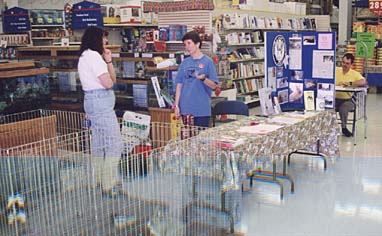 organizations around the world in a common mission -- to find loving homes for orphaned pets. Sponsored by Petsmart and the North Shore Animal League, this year's Pet Adoptathon was the fifth annual such weekend.
organizations around the world in a common mission -- to find loving homes for orphaned pets. Sponsored by Petsmart and the North Shore Animal League, this year's Pet Adoptathon was the fifth annual such weekend.
Buckeye HRS participated at the Fairlawn (Akron area) Petsmart . We took several foster bunnies along to meet the public and had lots of helpful rabbit-care information to hand out. Our display booth caught customers' attention with a selection of articles, as well as photos of past and present foster bunnies. It was nice to meet some of our NE Ohio members in person and also to be able to convey the joys and responsibilities of sharing our homes with rabbits to people new to the house-rabbit concept.
We were pleased to be part of an effort of this magnitude and look forward to participating again in the future.
go to index
This is to all the other Rabbit lovers. I wanted to tell you about a neat gift I received when my pet human, Eileen, and I moved into our new condo. When we lived in the apartment, I used to climb up on boxes to look outside the window. All I saw was a parking lot and people coming and going. I did like when the window was open so I could feel the breeze. After we moved, I got a real window seat. I get to look out on a courtyard and see birds and squirrels, leaves blooming in the warm weather, and snow falling in the winter.
I really like my window seat. During the day I eat my hay (very important), talk with my guinea pig condo mates, listen to the radio, and in the afternoon sit by the window and wait for Eileen to come home. I think these seats are called cat window seats. I really should write to them about changing the name.
go to index
Dear Buckeye HRS:
I think it's great that you have space for us bunny lovers to say good-bye to our wonderful companions. They are such an important part of our lives. So many people (non-bunny people) don't understand that they are as much a part of our families as our friends and relatives.
Thank you so much for all you do and keep up the good work!
Sincerely,
Lynn IhrigWe most definitely want to continue as local members. We look forward to the newsletter. We also want to make a donation in honor of Buster Smith. Buster had 10 long and happy years with Skip and Kristen Smith. In fact, Kristen inspired Henry and me to adopt Bundles.
Bundles celebrated her first birthday on Dec 21, 1998 and her adoption day day on Feb. 14, 1999! She wishes all other rabbits the best in finding a home.
Susan Porter and Henry Pintz
go to index
March 10, 1995 - February 4, 1999
My little chocolate bunny,
Momma's precious angel
The short time that you
shared with me
was so incredible
How I loved to watch you
clean your sweet face
and kick up your feet
as you ran and danced
Always so amusing
How I treasured your
bunny nudges - your gentle
reminders that you're there
and all the times you chinned me,
reminding me that I'm yours
I'll miss giving you bunny massages
and snuggling with you on the floor
Sharing fruit with you and
coming home to see your
sweet face greet me
You will always be
my number one bun-- Lynn Ihrig
go to index
Congratulations and best wishes to these cherished bunnies and their devoted human companions!
Celebrating in May:
Dusty, 5 years with Barb; Bambi, 1 year with Deanna; Beau and Milli, 3 and 2 years, respectively, with Eileen; Banana, 1 year with Karen; Antonio with Ty; Benjamin and Beatrice, 1 year with Judy; Cinnamon, 4 years with Jessica; Benny, 3 years with Trudy; Biscuit with Christine; Mister, 2 years with John; Flopsy and Penelope, 6 and 2 years, respectively, with Karen; Emmy and Skip with Kelly; Lucky, 4 years with Jacqueline.
Celebrating in June:
Merry, 7 years with Kathleen and David; Cinnamon and Samson, spoiled by the Coles for 4 and 2 years, respectively; Misty, 3 years with Deanna; Nicky, 2 years with Susan and Michele; Cocoa Bunny and Banana Jack, 1 year with Shannon; Duffy with Karen; Angel, 1 year with Pat; Sassi Frassi and Misti Lou, 2 years with Scott and Debbie; Zoe with Rob and Kim; Sunny, 5 years with Noelle; Cocoa, 2 years with Becky; Gabrielle with Kelly; Wilma, 9 years with Mary.
Celebrating in July:
Junie, 1 year with Karen; Dusty, 11 years with June; Caramel, 7 years with Lisa; Romeo, 8 years with Gina; Shadow, 2 years with Carla; Benjamin, 4 years with Terri and Jeremy; CD, 2 years with Missy.
Celebrating in August:
Talbot, 2 years with Susan and Michele; Taz, 4 years with Deanna; Rosebud, 3 years with Linda; Quince with Karen; Bailey, 1 year with Kimberly; Chloe, 7 years with Maggie; Piglet, 2 years with Lisa; Princess, 2 years with Trudy; Bear, 7 years with Carla; Orion, 2 years with Julie; Kisses, 2 years with Andrea; JR, 6 years with Penny.
go to index
This webzine is based entirely on the Harelines printed newsletter. The printed copy is sent out to members much before it appears here -- that's one way we can encourage you to support it by becoming a member. If you find you are reading this website regularly or with special appreciation, please consider becoming a member of the Buckeye House Rabbit Society.
| Now's the time to join! Your $10 membership donation pays for one year's issues of Harelines AND helps us help needy rabbits here in Ohio. We are an all-volunteer, federally-recognized non-profit organization and depend solely on YOUR generous support. Don't forget, your donation is tax-deductible! | 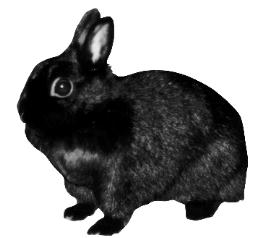 |
Don't let this issue of Harelines be the last to reach the web. Send your membership to us today!
go to index
Bunny Bytes, Outfitters of the Urban Rabbit, for their most generous donation. Bunny Bytes chose the Buckeye HRS as the recipient of a percentage of their 1998 sales. We feel honored indeed and appreciate this contribution all the more because 1998 was Bunny Bytes' very first year in business! If you're a new member or haven't visited their web site yet, check out www.bunnybytes.com today. They offer a wide variety of terrific products for rabbits and their human companions, from food and toys to rabbit-themed items for home and garden. Enjoy shopping with Bunny Bytes!
The following members whose thoughtful and generous donations are allowing us to help Buckeye HRS foster bunnies: Bob Piekarczyk, Natasha Miller, Kim Tutewiler, Vicki and Tony Ricci, Katherine Cull, Diane Dodge, Carol and Joe Danko, Irma Laszlo, Loreen Giese, Karen Sarver.
Kathleen Quinn, for her heartfelt contribution in memory of dear Pippin.
Amy Honaker, for her thoughtful donation in memory of Norman.
Lynn Ihrig for her kind gift in memory of her beloved Sigmund.
Our new Fulfillment Coordinator, Karen Salvagno, for volunteering her time and organizational skills to handle our fundraising items. Visit our giftshop for an updated order form and a complete list of available items. For those of you who prefer to use the order form included with the Special Edition Harelines (Summer 1998), the new address for ordering t-shirts, sweatshirts, mugs, and more is: Buckeye House Rabbit Society, c/o Karen Salvagno, P.O. Box 184, Litchfield, OH 44253. All profits are used to help a needy foster rabbit.
Our new Layout and Design Specialist, Ellen Eder, for taking on the time-consuming and exacting task of transforming our newsletter from a tangled heap of text and photos into the polished publication you're enjoying now!
As always, Alphagraphics of downtown Cleveland, for their ongoing discount on printing our materials.
Harelines, the Buckeye House Rabbit Society Newsletter, is published by the all-volunteer, non-profit Buckeye House Rabbit Society, Vickery, OH. The House Rabbit Society assumes no responsibility for errors or omissions.
Newsletter editor Herta Rodina
Layout and Design Ellen B. Eder
Contributing Writers
Kristi Cole, Eileen Matias, Dr. Cathy Palomar,
Herta Rodina
Webster
David Sharpe
go to beginning | contents | homepage
This page is maintained by David Sharpe (www.ohio.edu/people/sharpe)
Please send comments to
All rights reserved
![]()